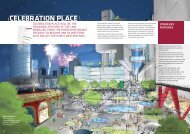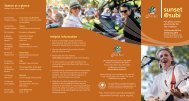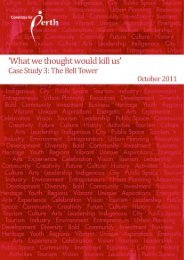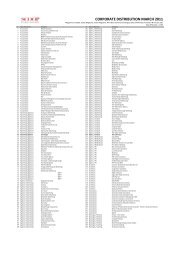The evolution of Perth's Passenger Rail, June 2011 - Committee for ...
The evolution of Perth's Passenger Rail, June 2011 - Committee for ...
The evolution of Perth's Passenger Rail, June 2011 - Committee for ...
You also want an ePaper? Increase the reach of your titles
YUMPU automatically turns print PDFs into web optimized ePapers that Google loves.
‘What we thought would kill us’<br />
Case Study 2: <strong>The</strong> Evolution <strong>of</strong> Perth’s <strong>Passenger</strong> <strong>Rail</strong><br />
<strong>June</strong> <strong>2011</strong>
Research Report: ‘What we thought would kill us’<br />
Case Study 2: <strong>The</strong> Evolution <strong>of</strong> Perth’s <strong>Passenger</strong> <strong>Rail</strong><br />
1. Introduction 2<br />
2. History and Controversy <strong>of</strong> Perth’s <strong>Passenger</strong> <strong>Rail</strong> 4<br />
2.1 Early rail integration ............................................................................................ 4<br />
2.2 Closure <strong>of</strong> Fremantle to Perth Line..................................................................... 5<br />
2.3 Electrification <strong>of</strong> the <strong>Rail</strong> System ........................................................................ 7<br />
2.4 Rapid Transit <strong>for</strong> the Northern Suburbs.............................................................. 7<br />
2.5 South West Corridor’s New Metro<strong>Rail</strong> ................................................................ 9<br />
3. Light <strong>Rail</strong> – <strong>The</strong> Next <strong>Rail</strong> Chapter <strong>for</strong> Perth? 11<br />
4. Key Issues, Opportunities and Challenges – What have we learnt? 12<br />
5. Conclusions and Recommendations 19<br />
Appendix 1 21<br />
Acknowledgements<br />
Appendix 2 22<br />
References<br />
!!!!!!!!!!!!<br />
!<br />
!!!!!!!!!!!!!!!!!!!!!!!!!!!!!!!"#$%&!'(')*!%&!+,'-*%.$/!,0!/$)!1,22%//))!0,*!3)*/$4!!5$%6)!7)!)8+,9*(.)!%/&!9&):!%/!&$,96;!%66!?&:!#$)!@A,69/%,8!,0!3)*/$B&!3(&&)8.)*!C(%6:!DEFF:!1,22%//))!0,*!3)*/$:!3)*/$4<br />
<strong>Committee</strong> <strong>for</strong> Perth 1
SECTION 1<br />
Introduction
“Perth’s public rail system is an<br />
example <strong>of</strong> Western Australian<br />
leadership and <strong>for</strong>esight”<br />
1. Introduction<br />
This report is the second in the ‘What we thought would kill us’ series being undertaken by the<br />
<strong>Committee</strong> <strong>for</strong> Perth. <strong>The</strong> purpose <strong>of</strong> the series is to examine controversial development and<br />
infrastructure projects in Perth and scrutinize the outcomes that they have achieved. <strong>The</strong> series<br />
aims to provide valuable insight into undertaking and enabling major development in Perth.<br />
This report examines three defining events in the history <strong>of</strong> Perth’s passenger transport system: the<br />
electrification <strong>of</strong> the Perth to Fremantle <strong>Rail</strong> line; the development and operation <strong>of</strong> the Northern<br />
Suburbs Rapid Transit system; and the development <strong>of</strong> Perth’s new metro rail – the South West <strong>Rail</strong><br />
line.<br />
It is a story <strong>of</strong> reluctant success, controversy and caution.<br />
Perth’s public rail system is an example <strong>of</strong> Western Australian leadership and <strong>for</strong>esight. It shows<br />
that as a community we can also be visionary and set the Australian benchmark <strong>for</strong> best practice. It<br />
also demonstrates that the people <strong>of</strong> Perth are willing to embrace public transport where an efficient<br />
and reliable service is <strong>of</strong>fered.<br />
However controversy has dogged and defined the development <strong>of</strong> Perth’s rail system since 1979<br />
when the government <strong>of</strong> the day announced the closure <strong>of</strong> the Perth – Fremantle railway and has<br />
continued to hinder projects, to varying degrees, through to the delivery <strong>of</strong> the south-west rail line.<br />
Controversy continues to feature in discussion on public transport planning in Perth today – as we<br />
face issues <strong>of</strong> capacity - just 20 years after the first major investments were made in the rail system.<br />
With longer peak hour periods bringing increasing congestion and a bus system that is reaching its<br />
limit in some areas, Perth could face an uncertain future in terms <strong>of</strong> moving its people between<br />
places <strong>of</strong> work, education, recreation and home.<br />
As a result there is a need, more than ever, <strong>for</strong> us to learn from the lessons <strong>of</strong> the past and develop<br />
another positive chapter in Perth’s rail story as part <strong>of</strong> the development <strong>of</strong> the public transport<br />
network, by embracing opportunities to expand the system and taking advantage <strong>of</strong> options such as<br />
light rail, which have strong community and business support.<br />
Perth’s rail story highlights a number <strong>of</strong> key issues <strong>of</strong> transportation planning in Perth:<br />
<strong>Committee</strong> <strong>for</strong> Perth 2
• Perth’s public loves rail. <strong>The</strong>y have been instrumental in driving the retention and extension <strong>of</strong><br />
the passenger rail system and have used metropolitan passenger railways in numbers which<br />
continuously exceeded planning predictions and expectations.<br />
• Investment in new rail takes political courage – particularly given that the planning and delivery<br />
timeframes are much longer than four year election cycles - however there is no evidence that<br />
any state government has been damaged at the polls <strong>for</strong> rail investment.<br />
• While the delivery and benefits <strong>of</strong> mass transit are <strong>of</strong>ten long term, governments that have<br />
committed to major transit projects are remembered <strong>for</strong> their <strong>for</strong>esight.<br />
• Transportation planners have a history <strong>of</strong> underestimating the potential and the take up <strong>of</strong> rail in<br />
Perth which has led to failures to adequately predict and cater <strong>for</strong> the long term needs <strong>of</strong> the<br />
service. <strong>The</strong>re has also been a tendency to favour investment in bus over rail based on short<br />
term cost benefits.<br />
• While bus transportation carries more passengers in total, rail carries more passengers per<br />
service kilometre (4.15 compared to 1.43 passengers per service kilometre <strong>for</strong> bus) at a lower<br />
average cost ($0.41 per passenger kilometre compared with an average $0.76 per passenger<br />
kilometre <strong>for</strong> bus). This indicates that rail is both more efficient and effective <strong>for</strong> mass public<br />
transportation, even in a lower density environment – something which is supported by data from<br />
around the world.<br />
• Perth is a growing metropolis and congestion is worsening which brings with it increased<br />
economic, environmental and social costs. With the population projected to double over the next<br />
40 years, congestion problems will reach crisis point without significant investment in the<br />
transportation system. <strong>Rail</strong> investment is costly – but the costs <strong>of</strong> congestion, inaccessibility and<br />
poor liveability are much higher.<br />
• Light rail is shaping up as an integral part <strong>of</strong> <strong>Perth's</strong> future rail solution. Light rail provides<br />
opportunities to connect our existing bus and rail transit systems and combines the benefits <strong>of</strong><br />
flexibility and mass transit efficiency.<br />
• <strong>The</strong>re has been a history <strong>of</strong> public transportation being a political issue in Perth with past state<br />
Labor governments being historically more proactive in investing in and delivering major<br />
upgrades and extensions <strong>of</strong> the rail network than Liberal governments. However today's Liberal<br />
government has announced a commitment to investigate light rail options in Perth and there is a<br />
need to ensure that any commitment to light rail development is delivered despite political<br />
cycles.<br />
• Transit corridors in Perth have delivered some land use value benefits, with, according to the<br />
Australian Property Institute, a value premium <strong>of</strong> approximately 15-35% <strong>for</strong> land centred on and<br />
immediately around stations, and some density benefits, however these have been limited. As<br />
Perth grows there will be many opportunities to accommodate medium and higher density<br />
development along both existing and potential future rail and light rail routes, and history<br />
indicates that these opportunities will need to be actively pursued through the public and private<br />
sectors.<br />
<strong>Committee</strong> <strong>for</strong> Perth 3
SECTION 2<br />
<strong>The</strong> History and Controversy <strong>of</strong><br />
Perth’s <strong>Passenger</strong> <strong>Rail</strong>
“Perth grew around the rail and<br />
tramways, spreading out on an eastwest<br />
axis, with commercial nodes<br />
and pockets <strong>of</strong> higher density<br />
housing dotted along its route”<br />
2. <strong>The</strong> History and Controversy <strong>of</strong> Perth’s <strong>Passenger</strong> <strong>Rail</strong><br />
2.1 Early rail integration<br />
<strong>The</strong> electrification <strong>of</strong> the Fremantle, Midland and Armadale lines, the development <strong>of</strong> the Northern<br />
Suburbs Transit line and the construction <strong>of</strong> the South West <strong>Rail</strong> line are all part <strong>of</strong> a long term<br />
project which has seen the resurrection <strong>of</strong> the passenger rail system in Perth.<br />
During the 1970s the passenger rail system, running with diesel engines, had been allowed to<br />
decline, with minimal investment over the preceding decades. <strong>The</strong> system consisted <strong>of</strong> only three<br />
lines, the Armadale, Fremantle and Midland lines which provided a relatively uncom<strong>for</strong>table and out<br />
<strong>of</strong> date service and, as a result, attracted minimal patronage. <strong>The</strong> Fremantle line was also shared by<br />
freight rail traffic, limiting service efficiency (University <strong>of</strong> Melbourne, 2010).<br />
<strong>The</strong> lack <strong>of</strong> investment in the rail system was a by-product <strong>of</strong> Perth’s post war love affair with the<br />
private car. Planning <strong>for</strong> a new era <strong>of</strong> growing car ownership led to low density suburban<br />
development, which sprawled out into fringe areas without thought to the need to encourage walking<br />
and cycling; provide access to facilities and services; or enable public transport use. <strong>The</strong> focus <strong>of</strong><br />
the era was on the convenience <strong>of</strong> the private car and there was a prevailing view that public<br />
transport use would be limited to people who did not have access to a car.<br />
However Perth was not always this way. <strong>The</strong> Fremantle-Guil<strong>for</strong>d <strong>Rail</strong>way began the Swan River<br />
Colony’s commitment to urban rail. This was followed by an extension <strong>of</strong> the railway system to<br />
Armadale and the further growth <strong>of</strong> the passenger transport system through the introduction <strong>of</strong><br />
electric trams in the late 1890s, when they were the latest in modern technology (Perth Electric<br />
Tramway Society, <strong>2011</strong>).<br />
Perth grew around the rail and tramways, spreading out on an east-west axis, with commercial<br />
nodes and pockets <strong>of</strong> higher density housing dotted along its route. <strong>The</strong> rail and tram system<br />
provided the impetus <strong>for</strong> the development <strong>of</strong> some <strong>of</strong> our most celebrated local centres and<br />
suburban areas which remain among the best examples <strong>of</strong> transit oriented development in the<br />
region.<br />
Public transport remained central to planning <strong>for</strong> Perth until the 1960s.<br />
<strong>Committee</strong> <strong>for</strong> Perth 4
In 1955 Stephenson and Mr JA (Alistair) Hepburn, the Town Planning Commissioner, released the<br />
Plan <strong>for</strong> the Metropolitan Region, Perth and Fremantle, 1955 (known as the Stephenson-Hepburn<br />
Report 1955).<br />
It was a detailed publication which examined life in Perth and suggested how the city might be<br />
developed <strong>for</strong> a projected metropolitan population <strong>of</strong> 1,400,000 by the end <strong>of</strong> the century (Barker M,<br />
2007). This proved to be a highly reliable <strong>for</strong>ecast: at the turn <strong>of</strong> the century Perth had a population<br />
<strong>of</strong> approximately 1,300,000.<br />
<strong>The</strong> Stephenson-Hepburn Plan proposed a road network to cope with 400% more traffic than there<br />
was in 1955 and recommended the construction <strong>of</strong> eight new highways with a total length <strong>of</strong> about<br />
85 miles. However the plan also allowed <strong>for</strong> the extension <strong>of</strong> suburban rail systems, particularly<br />
given that the tram system was, by then, substantially lost (Barker M, 2007).<br />
<strong>The</strong> plan reflected that the car was the popular and growing means <strong>of</strong> transport at the time and its<br />
emphasis was on the need to have a modern road system supported by an effective rail system.<br />
However, in implementation no new rail lines were developed and the new suburbs to the north<br />
and south <strong>of</strong> the city were dependant on the provision <strong>of</strong> bus services as the only alternative to<br />
private cars.<br />
As a result, the Metropolitan Improvement Fund, which was established to enable the<br />
implementation <strong>of</strong> the plan, was used to purchase most <strong>of</strong> the land <strong>for</strong> the new highways but not <strong>for</strong><br />
new rail corridors. <strong>The</strong>re<strong>for</strong>e, despite the development <strong>of</strong> a high quality integrated strategic plan<br />
which was highly accurate and had great <strong>for</strong>esight, the focus <strong>of</strong> transportation planning <strong>for</strong> Perth<br />
shifted toward the modern American model which favoured planning roads and freeways to enable<br />
effective movement <strong>of</strong> cars and providing buses to meet public transport needs.<br />
It is there<strong>for</strong>e not surprising that by the late 1970s Perth’s suburban lifestyle was highly automobile<br />
dependent; the tram system had closed and the suburban rail system was suffering from decreasing<br />
patronage under a lack <strong>of</strong> investment.<br />
2.2 Closure <strong>of</strong> Fremantle to Perth Line<br />
In 1970, the Perth Regional Transport Study was undertaken to determine Perth’s transport needs<br />
during the 20 year period to 1989. <strong>The</strong> study identified a series <strong>of</strong> transportation alternatives and<br />
evaluated the costs and benefits <strong>of</strong> each. <strong>The</strong> final report recommended the removal <strong>of</strong> existing<br />
passenger rail lines and replacing them with buses running in the rail reserves.<br />
A sequel to the report, prepared in 1972, came to the same conclusions as the original study. <strong>The</strong>se<br />
findings were supported by the subsequent Bureau <strong>of</strong> Transport Economics in the 1973 Perth<br />
Fremantle Corridor Study; the 1974 Perth Central City <strong>Rail</strong>way Feasibility Study; and the 1978 report<br />
<strong>Rail</strong> and Bus Policies <strong>for</strong> the Fremantle Corridor.<br />
<strong>The</strong> government <strong>of</strong> the day under Premier Sir Charles Court accepted that at least the Fremantle line<br />
should be closed and replaced by buses, which it did in September 1979.<br />
<strong>The</strong> rail closure was justified on the basis that it was needed in order to provide best service (through<br />
buses) <strong>for</strong> least cost, while still enabling an alternative to the private car and only making use <strong>of</strong> rail<br />
where justified by patronage (Minister <strong>for</strong> Transport, 1979).<br />
<strong>The</strong> then Minister <strong>for</strong> Transport’s Bus and <strong>Rail</strong> Policy <strong>for</strong> Perth cited factors such as declining<br />
patronage; a lack <strong>of</strong> growth potential; the need <strong>for</strong> capital cost savings and operating cost savings;<br />
potential <strong>for</strong> increased efficiency in energy usage and road planning benefits as reasons <strong>for</strong> closing<br />
the passenger rail line. It also promoted the advantage <strong>of</strong> removing freight rail traffic from the<br />
passenger rail system (Minister <strong>for</strong> Transport, 1979).<br />
<strong>The</strong> Government’s preferred road corridor and bus-way option was also promoted as having local<br />
amenity advantages over other schemes – including noise reduction, improved safety and a better<br />
local environment (to be achieved by separating the main highway from houses by frontage roads)<br />
(Minister <strong>for</strong> Transport, 1979). This was a common and popular road and urban planning technique<br />
at the time.<br />
<strong>Committee</strong> <strong>for</strong> Perth 5
<strong>The</strong> rail closure ignited a community campaign to bring back passenger rail to the Perth – Fremantle<br />
corridor and incited debate on upgrading and extending the rail system.<br />
High pr<strong>of</strong>ile pr<strong>of</strong>essional associations such as the Australian Planning Institute opposed the rail<br />
closure and called <strong>for</strong> the decision to be reversed. Fremantle City Council also opposed the closure<br />
and made representations to the State Government on the issue along with other local authorities<br />
situated on the rail route.<br />
A small community group <strong>of</strong> concerned citizens and experts called Friends <strong>of</strong> the <strong>Rail</strong>way (FOR)<br />
<strong>for</strong>med to oppose the rail closure.<br />
FOR gained wide public support and organised a petition calling <strong>for</strong> a reversal <strong>of</strong> the decision and a<br />
reassessment <strong>of</strong> transportation priorities <strong>for</strong> the metropolitan region (FOR, 1979). <strong>The</strong>y developed a<br />
comprehensive attack on the government’s policy and decision making process and publically<br />
questioned the government’s transportation policy that:<br />
• alleged the lack <strong>of</strong> ongoing investment in the Perth to Fremantle rail system was the catalyst <strong>for</strong><br />
the system’s decline;<br />
• claimed that patronage levels had been underestimated and that the capital and operating costs<br />
<strong>of</strong> maintaining the rail service had been grossly overstated by the government;<br />
• asserted that there was considerable potential <strong>for</strong> an increase in the patronage <strong>of</strong> the Perth-<br />
Fremantle line; and<br />
• identified issues <strong>of</strong> energy vulnerability and the potential <strong>for</strong> a shortfall in oil supplies to highlight<br />
the need <strong>for</strong> energy efficient public transport and in particular the provision and electrification <strong>of</strong><br />
passenger railways.<br />
FOR strongly questioned the approach <strong>of</strong> developing Perth as an automobile city at a time when<br />
public transport strategies around the world were under large scale review due to the increased cost<br />
<strong>of</strong> motoring and the environmental and social costs <strong>of</strong> congestion, noise and air pollution.<br />
<strong>The</strong>y proposed an alternative transportation policy <strong>for</strong> Perth which involved retaining and upgrading<br />
the Perth to Fremantle passenger rail service and the entire passenger rail network including:<br />
• undertaking a campaign to improve patronage <strong>of</strong> the rail service and improve use <strong>of</strong> the<br />
corridors’ transportation resources by integrating bus and rail at key stations;<br />
• improving facilities <strong>for</strong> parking cars and bicycles at stations;<br />
• removing the fare charged <strong>for</strong> bicycles;<br />
• publicising rail and improving fare collection;<br />
• the electrification <strong>of</strong> all three rail lines within 5 years;<br />
• shifting the freight rail line; and<br />
• increasing population density along stations and introducing an integrated transport system <strong>of</strong><br />
bicycle ways, bus priority lanes and pool incentives as well as the upgraded train service to<br />
increase patronage (FOR, 1979).<br />
As a recommended long-term policy, FOR suggested the extension <strong>of</strong> the rail line through the northwestern<br />
corridor to Joondalup and enabling increased densities along the route as well as extending<br />
the system to Rockingham.<br />
In 1982, the Director General <strong>of</strong> Transport released a new transport policy, Transport 2000: A Perth<br />
Study, which consolidated the view that planning <strong>for</strong> Perth should focus on providing <strong>for</strong> private cars<br />
with the role <strong>of</strong> the public transport system limited to enabling commuter traffic into the city centre<br />
and providing <strong>for</strong> people without access to a motor vehicle.<br />
It was believed that the existing and planned road system would be able to withstand projected<br />
growth in traffic with the exception <strong>of</strong> the Narrows Bridge. Bus transit was recommended to alleviate<br />
congestion on the Narrows Bridge as well as provide public transport to the northern and southern<br />
corridors. <strong>The</strong> report found that electrification <strong>of</strong> the remaining railways was not economically viable<br />
(Knox, 1982).<br />
<strong>The</strong> release <strong>of</strong> the 1982 study indicated that the government was firmly committed to the eventual<br />
closure <strong>of</strong> the railways and the development <strong>of</strong> a public transport system based entirely on buses<br />
and, as a result, community controversy heightened. <strong>The</strong> issue became a major focus <strong>of</strong> the<br />
local media resulting in the future <strong>of</strong> the public transport system becoming a major focus <strong>of</strong> the<br />
<strong>Committee</strong> <strong>for</strong> Perth 6
1983 election.<br />
While the government held fast to their decision, the then opposition announced they would support<br />
the re-opening <strong>of</strong> the railway if elected (Newman P, <strong>2011</strong>).<br />
<strong>The</strong> election was held in early 1983 and a large swing saw the incumbent government defeated.<br />
<strong>The</strong> rail service was reopened by the newly elected government on 29 July 1983 with much fanfare<br />
as public transport patronage in the corridor returned. Studies were commissioned to examine the<br />
potential to electrify the passenger rail system (Westrail, 1984).<br />
2.3 Electrification <strong>of</strong> the <strong>Rail</strong> System<br />
Following the re-opening <strong>of</strong> the Fremantle line, the condition <strong>of</strong> the passenger rail system needed to<br />
be addressed. <strong>The</strong> Westrail annual report <strong>for</strong> 1984 estimated that during 1983/84 the suburban rail<br />
passenger service carried an estimated eight million passengers, compared to 6.6 million in the<br />
preceding year when the Perth-Fremantle line was not in operation (Westrail, 1984).<br />
<strong>The</strong> government created an inquiry into the electrification <strong>of</strong> the suburban rail system. This inquiry<br />
reported to government in <strong>June</strong> 1985, recommending that the system be electrified without delay on<br />
the basis that the cost <strong>of</strong> maintenance would be lower and that there was already a need <strong>for</strong> 75% <strong>of</strong><br />
the existing rolling stock to be replaced (Co-ordinator General <strong>of</strong> Transport, 1985).<br />
In late 1985, a $200 million project was awarded to Asea-Walker and Westrail respectively <strong>for</strong> rail<br />
car construction and electrical work and track upgrading on the Fremantle, Armadale and Midland<br />
rail lines.<br />
Once this major upgrade to the public transport system was announced, debate immediately turned<br />
towards the need <strong>for</strong> a transit system to serve Perth’s northern corridor which was increasingly<br />
plagued by peak hour congestion on the Mitchell Freeway. In 1986 the government announced a<br />
study into the most appropriate <strong>for</strong>m <strong>of</strong> rapid transit <strong>for</strong> the growing northern corridor (Northern<br />
Suburbs Transit System, 2009).<br />
2.4 Rapid Transit <strong>for</strong> the Northern Suburbs<br />
As previously outlined, despite initial provision <strong>for</strong> rail corridors in the Stephenson-Hepburn Report,<br />
Perth’s northern suburbs were developed with a high quality road system, but without provision <strong>for</strong><br />
rail transit.<br />
However, by the 1980's the freeway serving the corridor was becoming congested at peak hour and<br />
the community was dissatisfied with the bus service (Newman P, <strong>2011</strong>).<br />
<strong>The</strong> government initiated studies to determine the most appropriate transit service <strong>for</strong> the northern<br />
corridor.<br />
<strong>The</strong> first study was undertaken in September 1988 and concluded that a rapid transit system <strong>for</strong> the<br />
north-western corridor whether it be a bus based or rail based system was economically justified and<br />
had wide public support. <strong>The</strong> consultants’ preferred option was <strong>for</strong> a bus-based system to be<br />
located within the median <strong>of</strong> Mitchell Freeway (DOT, 1989).<br />
During the course <strong>of</strong> the study, two other major decisions were made about Perth’s existing<br />
transportation corridors including the 1988 Cabinet approval <strong>of</strong> the electrification <strong>of</strong> the existing<br />
suburban rail network and approval <strong>of</strong> the Kwinana Freeway Exclusive Bus Lane, which was to<br />
provide <strong>for</strong> an improved bus transit service <strong>for</strong> the southern corridor.<br />
This only left the growing northern corridor without a public transit spine. Pressure increased on the<br />
government <strong>for</strong> a solution with the public calling <strong>for</strong> the solution to be rail and strongly lobbying<br />
government <strong>for</strong> a passenger rail service. At one stage the Member <strong>for</strong> Whit<strong>for</strong>ds was receiving 200<br />
letters a day supporting passenger rail (Newman P, 1991).<br />
Acknowledging the public mood, the government announced that a review panel would be <strong>for</strong>med to<br />
provide a strategic overview <strong>of</strong> Perth’s public transport system; an integrated perspective on recent<br />
<strong>Committee</strong> <strong>for</strong> Perth 7
public transport planning decisions; review strategies adopted by other cities in solving their<br />
transport problems and review the consultants’ analysis <strong>of</strong> rapid transit options <strong>for</strong> Perth’s northern<br />
suburbs (DOT, 1989).<br />
In 1988 the review panel presented its findings to the Minister <strong>for</strong> Transport and suggested that:<br />
• a window <strong>of</strong> opportunity existed <strong>for</strong> the completion <strong>of</strong> basic rail infrastructure.<br />
• as the city continued to grow, completion <strong>of</strong> rail transit spines was seen as essential.<br />
• the best rapid transit option <strong>for</strong> the northern suburbs would involve a rail trunk line service with<br />
integrated feeder/distributor services.<br />
• rail provided the best quality, most efficient service.<br />
• projected patronage was adequate to justify service.<br />
• considerable economies <strong>of</strong> scale would be achievable in integrating construction <strong>of</strong> the northern<br />
suburbs railway with existing suburban rail.<br />
• the line would enhance the efficiency <strong>of</strong> the rail service as a whole.<br />
• bus feeder services could be directed across the corridor.<br />
• a rail based service would achieve operating cost savings compared to a bus based system.<br />
<strong>The</strong>se cost savings would be <strong>of</strong>fset against any initial capital cost disadvantage.<br />
• a railway would provide opportunities <strong>for</strong> more intensive urban development in the vicinity <strong>of</strong> rail<br />
stations and may enhance development opportunities at other points along the route.<br />
• private developers may provide infrastructure or contribute to the financing <strong>of</strong> the railway in<br />
return <strong>for</strong> benefits conferred by accessibility to the rail system (DOT, 1989).<br />
As a result <strong>of</strong> the Review Panel’s report and recommendations, Cabinet on 12 December 1988 gave<br />
approval, in principle, <strong>for</strong> an electrified railway line to serve the northern suburbs. <strong>The</strong> Perth Urban<br />
<strong>Rail</strong> Electrification Steering <strong>Committee</strong> was asked to prepare a master plan <strong>for</strong> the railway.<br />
Enabling legislation <strong>for</strong> the railway option was passed by Parliament on 15 January 1989.<br />
Objectives <strong>for</strong> the project included:<br />
• reducing operating costs <strong>for</strong> the public transport operator;<br />
• converting car drivers to public transport users, thereby increasing public transport use;<br />
• maximising patronage and reducing road traffic levels;<br />
• providing improved levels <strong>of</strong> service and satisfaction to public transport users;<br />
• encouraging higher density nodal development around railway stations in the northern<br />
suburbs in order to reduce urban sprawl (McDougall and Piotrowski, 1994).<br />
In determining the required capacity <strong>of</strong> the railway, the Steering <strong>Committee</strong> based its decision<br />
making on projections that the population <strong>of</strong> the corridor would be generally stable or slowly<br />
declining in areas south <strong>of</strong> Wanneroo. <strong>The</strong> Steering <strong>Committee</strong> also considered that the variability<br />
<strong>of</strong> the population growth rate in the region would have relatively small effects on rail passenger<br />
demand although it would increase the share <strong>of</strong> central city employment taken by residents in the<br />
corridor. It was not expected that there would be significant increases in passenger rail volumes<br />
until Perth was a much bigger city.<br />
More rapid growth in passenger numbers was expected to come from growth <strong>of</strong> the corridor itself to<br />
well beyond Joondalup and Burns Beach Road. This was predicted to increase passenger demand<br />
but not as strongly as if the growth was located immediately adjacent to the rail stations.<br />
It was <strong>for</strong>ecast that the trains would carry nearly 13,000 inbound passengers during the weekday<br />
morning peak two hours in 2001. Of these 13,000 nearly 12,000 would be on trains south <strong>of</strong><br />
Scarborough Beach Road.<br />
It was also predicted that patronage beyond 2001 would be affected by continuing population<br />
growth; employment; car ownership; and costs <strong>of</strong> public and private transport. <strong>The</strong> future use <strong>of</strong> rail<br />
was expected to be strongly influenced by the level <strong>of</strong> employment in central Perth as the primary<br />
destination.<br />
<strong>Committee</strong> <strong>for</strong> Perth 8
<strong>The</strong> Steering <strong>Committee</strong> recognised that the main planning issue imposed by patronage increase<br />
was the extent to which rail capacity can be expanded and the adequacy <strong>of</strong> stations if more intensive<br />
land uses are developed in their vicinity.<br />
<strong>The</strong> northern suburbs rail line was completed in 1993, with twin track from Perth to Currambine and<br />
eight stations, five <strong>of</strong> which are major bus/train interchanges, and six <strong>of</strong> which are park and ride<br />
based (University <strong>of</strong> Melbourne, 2010).<br />
<strong>The</strong> capital cost <strong>for</strong> the system was $277 million in 1993 ($440 million in 2010 figures) <strong>for</strong> the entire<br />
infrastructure and the railcar fleet <strong>of</strong> 22 two-car rail sets. This was higher than initial estimations<br />
detailed in 1988, although the scope <strong>of</strong> the project increased substantially (railway was extended;<br />
station designs embellished and railcar specifications upgraded).<br />
Westrail’s 1994 Annual Report states that first year passenger numbers on the Perth to Joonalup<br />
line were significantly higher than planning predictions (Westrail, 1994).<br />
2.5 South West Corridor’s New Metro<strong>Rail</strong><br />
In conjunction with the 1989 election and passage <strong>of</strong> legislation on the Northern Suburbs Transit<br />
System, the government announced in February 1989 that it was committed to examining the<br />
possibilities <strong>for</strong> extending the railway to the South West.<br />
However, once again the first studies and proposals developed in the early 1990s <strong>for</strong> a mass transit<br />
mode <strong>for</strong> the southern corridor again heavily favoured buses.<br />
This was partially due to the recent construction <strong>of</strong> a bus-way down the Kwinana Freeway which had<br />
delivered some positive benefit to the southern suburbs. However once again there was a high level<br />
<strong>of</strong> public support <strong>for</strong> rail and support from within government which resulted in the government’s<br />
acceptance <strong>of</strong> the need <strong>for</strong> a rail route from Perth to Mandurah (Martinovich, 2007).<br />
In December 1994, the Metropolitan Region Scheme was amended to include the original route <strong>for</strong><br />
the Mandurah <strong>Rail</strong>way, via Kenwick and in July 1995, the government announced the new line to<br />
Mandurah (via Kenwick) and committed to complete the line from Kenwick to Jandakot by 2005<br />
(Department <strong>of</strong> Transport, 2000).<br />
In April 1997, the same government approved funding <strong>for</strong> the South West Metropolitan <strong>Rail</strong>way<br />
Master Plan, which was completed in April 2000.<br />
<strong>The</strong> initial Master Plan aimed to provide a fast, regular, com<strong>for</strong>table, safe and attractive electric<br />
passenger train service <strong>for</strong> the south west, comparable in both convenience and cost with the private<br />
car (Department <strong>of</strong> Transport, 2000).<br />
<strong>The</strong> service was proposed to have as few stations as possible so the train could run at 130kph<br />
(maximum speed) however the route was not universally supported. <strong>The</strong> train was proposed to run<br />
down the freeway from Mandurah to the edge <strong>of</strong> the Perth suburban area and then follow the<br />
existing freight line, towards the Armadale line, adding time to the journey and making it less<br />
competitive in comparison to the private car.<br />
However the 2001 state election saw a change <strong>of</strong> government, and a new Minister <strong>for</strong> Planning and<br />
Infrastructure who focussed on developing a more direct route <strong>for</strong> the new rail service.<br />
This resulted in a second master plan being prepared with an amended route to enable a direct<br />
passage to Perth across the Narrows Bridge and through the centre <strong>of</strong> the city. This masterplan<br />
aimed to increase journey speed, reduce infrastructure requirements and increase patronage.<br />
However the amended route was not without controversy. <strong>The</strong> route required the rail line to come<br />
through the front end <strong>of</strong> the city and tunnel under the city to link into the Northern Suburban <strong>Rail</strong> line<br />
and this was not wholly supported by the City <strong>of</strong> Perth at the time due to concerns that the rail line<br />
would be unsightly.<br />
<strong>Committee</strong> <strong>for</strong> Perth 9
At the same time an anti-rail group began to vocalise concerns that the tunnel under the city was<br />
impossible to construct as it was through s<strong>of</strong>t sand. However these issues were resolved and the<br />
opposition faded (Newman P, <strong>2011</strong>).<br />
<strong>The</strong> contracts <strong>for</strong> packages <strong>of</strong> work began to be let in late 2003 and construction began in February<br />
2004.<br />
Intense media scrutiny began and each step <strong>of</strong> completion was marked with considerable public<br />
interest, especially when the tunnel under the city was completed ahead <strong>of</strong> schedule.<br />
In early 2005 another State Government election was held and an anti-rail group ran a media<br />
campaign claiming that the rail line was a waste <strong>of</strong> public funds and that there was no need <strong>for</strong> a<br />
commuter rail service from Mandurah to Perth which they said would only serve a small number <strong>of</strong><br />
Mandurah residents (<strong>The</strong> West Australian, 2005).<br />
However the government was re-elected and held fast to its plans. <strong>The</strong> southern suburbs railway<br />
opened in December 2007 and has been an overwhelming success, with passenger numbers far<br />
exceeding predictions from the outset.<br />
<strong>The</strong> line delivered 11 new railway stations in the first phase. During the construction phase there<br />
was considerable development activity within the corridor, evidence that the railway acted as a<br />
catalyst <strong>for</strong> new development within the transit corridor, and many property developers chose to<br />
promote access to the railway as a key feature in the marketing <strong>of</strong> their development (Curtis C,<br />
2008).<br />
Routing the rail line through the city also proved to be a major catalyst <strong>for</strong> redevelopment in the city<br />
centre, being a major driver <strong>for</strong> proposals such as the Perth Waterfront and Northbridge Link.<br />
<strong>Committee</strong> <strong>for</strong> Perth 10
SECTION 3<br />
Light <strong>Rail</strong> - <strong>The</strong> Next Chapter <strong>for</strong> Perth?
“It is evident that new, integrated land<br />
use and transportation initiatives are<br />
required to address the need to<br />
house Perth’s increasing population”<br />
3. Light <strong>Rail</strong> – <strong>The</strong> Next <strong>Rail</strong> Chapter <strong>for</strong> Perth?<br />
!<br />
!<br />
!<br />
Despite the success <strong>of</strong> Perth’s rail trans<strong>for</strong>mation to date, the upgrade and expansion <strong>of</strong> the rail<br />
system has coincided with a period <strong>of</strong> rapid population growth in the metropolitan region. In the early<br />
1980s, when Perth’s rail trans<strong>for</strong>mation began, Perth had a population <strong>of</strong> approximately 900,000.<br />
Today the metropolitan population is estimated to be close to 1.7 million – nearly double.<br />
This means that even though public transportation patronage has been improved, congestion has<br />
worsened. It is evident that new, integrated land use and transportation initiatives are required to<br />
address the need to house Perth’s increasing population in a sustainable manner and ensure that<br />
the liveability <strong>of</strong> the city is retained – a major component <strong>of</strong> which is enabling a high level <strong>of</strong><br />
accessibility by public and private transportation.<br />
<strong>The</strong> state government’s recently released land use strategy, Directions 2031, recognises this need<br />
and Perth is currently awaiting the release <strong>of</strong> a new transportation strategy which will provide the<br />
strategic direction to address these issues.<br />
In December 2010 the Premier announced that light rail should be developed in Perth in the next<br />
decade. This announcement has been applauded by the public and business communities and<br />
could be the next major positive step in Perth’s rail trans<strong>for</strong>mation.<br />
Opportunities <strong>for</strong> light rail in Perth have been touted <strong>for</strong> the last three decades <strong>for</strong> routes which range<br />
from Perth’s north-eastern suburbs; to south-western centres such as Rockingham; to inner city<br />
links; to a system linking Perth’s major university campuses. However the Premier’s announcement<br />
was the first time that any government has publically supported the development <strong>of</strong> new light rail in<br />
Perth <strong>for</strong> more than 50 years.<br />
Light rail has exceptional capacity <strong>for</strong> mass transit and is suitable <strong>for</strong> ‘retro-fitting’ in cities due to its<br />
characteristics <strong>of</strong> combining the flexibility <strong>of</strong> buses with the benefits <strong>of</strong> a fixed transport system (like<br />
rail). <strong>The</strong>re are numerous recent examples <strong>of</strong> light rail being successfully developed in cities around<br />
the world, such as Dublin, Seattle, Portland and Calgary and there are opportunities <strong>for</strong> Perth to<br />
learn from their success.<br />
<strong>Committee</strong> <strong>for</strong> Perth 11
SECTION 4<br />
Key Issues, Opportunities and Challenges
“Perth’s rail story demonstrates that<br />
investment in rail is and always has<br />
been a cost effective solution <strong>for</strong><br />
public transportation in Perth”<br />
4. Key Issues, Opportunities and Challenges – What have we learnt?!<br />
<strong>The</strong> history <strong>of</strong> our passenger rail system and opportunities <strong>for</strong> future public transportation highlight a<br />
number <strong>of</strong> key issues which we can learn from in planning <strong>for</strong> public transportation in Perth in the<br />
future. <strong>The</strong>se are discussed below.<br />
Issue<br />
What can we learn?<br />
Perth’s public<br />
has been the<br />
champion <strong>of</strong><br />
rail investment<br />
Investment in passenger rail has never been strongly opposed by Perth’s<br />
public, quite the opposite – Perth’s community has championed rail. <strong>The</strong>y<br />
have demanded it and they have used it in numbers which continue to<br />
exceed predictions.<br />
<strong>The</strong> catalyst <strong>for</strong> Perth’s rail trans<strong>for</strong>mation was the closure <strong>of</strong> the Perth-<br />
Fremantle passenger rail line however similar public activism could be<br />
generated as the costs <strong>of</strong> congestion increase and the rail system fails to<br />
meet Perth’s growing transportation needs.<br />
This is already starting to happen. Perth’s population has grown faster than<br />
was predicted in the late 1980s and 1990s and the city’s larger population<br />
expects high quality public transit more than ever be<strong>for</strong>e.<br />
This is reflected in the fact that many <strong>of</strong> Perth’s advocacy and peak industry<br />
groups and local authorities are already actively advocating <strong>for</strong> improved rail<br />
or light rail services in the region.<br />
Further public dissatisfaction with problems <strong>of</strong> congestion and poor public<br />
transport service is likely to result in increased advocacy and community<br />
activism on this issue, particularly if the long awaited transportation strategy<br />
<strong>for</strong> Perth continues to be delayed – or if it fails to meet public expectations.<br />
<strong>The</strong> history <strong>of</strong> the passenger rail system in Perth there<strong>for</strong>e serves to caution<br />
governments <strong>of</strong> all persuasions about inadequate investment in rail, because<br />
it is an issue that the Perth public care about, and one on which elections can<br />
be won or lost.<br />
<strong>Committee</strong> <strong>for</strong> Perth 12
Issue<br />
What can we learn?<br />
Increasing<br />
congestion in<br />
Perth<br />
Despite the investment in passenger rail that has occurred over recent<br />
decades, there is clearly a need <strong>for</strong> additional improvements to the public<br />
transportation network in Perth to address issues <strong>of</strong> population growth and<br />
worsening congestion.<br />
Perth’s population has nearly doubled since the initial controversy that<br />
resulted in investment in the rail system. <strong>The</strong>re<strong>for</strong>e, while the system has<br />
greatly improved, Perth’s transportation needs have grown exponentially and<br />
our transportation needs today are greater than they have ever been be<strong>for</strong>e.<br />
Road congestion is becoming the primary transportation problem in Perth.<br />
This is due to a number <strong>of</strong> key factors including population growth (much <strong>of</strong><br />
which has been focussed in outer lying areas); a reduction in persons per<br />
dwelling; increased percentage and number <strong>of</strong> single occupant vehicles as<br />
the primary mode <strong>of</strong> transport; growth in car ownership outstripping<br />
population growth; and continued low overall percentage share <strong>of</strong> alternative<br />
<strong>for</strong>ms <strong>of</strong> transport (Kleyweg, 2007).<br />
Congestion has negative impacts that we are all familiar with – and would<br />
rather live without, including increased travel time and cost, decreased<br />
amenity, increased pollution, decreased economic efficiency and reduced<br />
liveability in the city.<br />
<strong>The</strong>re are also significant economic effects. <strong>The</strong> Bureau <strong>of</strong> Infrastructure,<br />
Transport and Regional Economics estimates that the cost <strong>of</strong> congestion in<br />
Australian capital cities was $9.4 billion in 2005 and will rise to $20.4 billion in<br />
2020. In Perth, the cost is expected to increase from $0.9 billion in 2005 to an<br />
estimated $2.1 billion in 2020 (Engineers Australia, 2010).<br />
And there are productivity impacts. <strong>The</strong> State <strong>of</strong> Australian Cities 2010 report<br />
said the movement <strong>of</strong> goods in Australian capital cities would increase 70%<br />
between 2003 and 2020 and in 2005 the Council <strong>of</strong> Australian Governments<br />
predicted that vehicle kilometres travelled in Perth would increase by 40% in<br />
the period from 2005 to 2020 to reach 20.6 billion. This was based on<br />
predictions which included a 23% increase in population to 2021; a <strong>for</strong>ecast<br />
doubling in container freight to 2015 and a quadrupling by 2030; and growth<br />
in traffic tasks in the vicinity <strong>of</strong> the airport due to the redevelopment <strong>of</strong> the<br />
domestic and international terminals and non-aviation developments.<br />
This is happening already. Since 2005 Perth’s population has already grown<br />
by an estimated 20% and, according to Perth Airport, air travel from Perth’s<br />
airports has doubled in the last ten years from 5,220,840 in 2000-2001 to<br />
10,463,800 in 2010 (Department <strong>of</strong> Infrastructure and Transport, 2010). As a<br />
result we can possibly already expect that the cost <strong>of</strong> congestion in Perth is<br />
pushing up towards the $2 billion mark.<br />
<strong>The</strong> increase in congestion is reflected in the rising travel time <strong>of</strong> journeys in<br />
Perth. Main Roads WA figures show that on some <strong>of</strong> the most congested<br />
routes, drivers now spend up to 70% more time in their cars driving to work in<br />
the mornings than in the early 1990s (Engineers Australia, 2010).<br />
This highlights the fact that there will be a need <strong>for</strong> continuous expansion and<br />
upgrade <strong>of</strong> passenger transportation in order to maintain pace with the city’s<br />
growth.<br />
<strong>The</strong> Engineers Australia 2010 Infrastructure Report Card identifies a specific<br />
need <strong>for</strong> mass transit to Perth’s north-eastern suburbs, and given Perth’s<br />
continuing northern expansion this should be addressed as part <strong>of</strong> the state’s<br />
transportation plan.<br />
<strong>Committee</strong> <strong>for</strong> Perth 13
Issue<br />
What can we learn?<br />
<strong>Rail</strong> is not cost<br />
effective in<br />
Perth<br />
Perth’s rail story demonstrates that investment in rail is and always has been<br />
a cost effective solution <strong>for</strong> public transportation in Perth.<br />
<strong>The</strong>re were 56.4 million urban rail passenger boardings in 2009/2010 on the<br />
five current passenger rail lines. This increased 57.5% since the introduction<br />
<strong>of</strong> the south-west transit line alone (from 35.8 million boardings in 2006/07).<br />
<strong>The</strong> investment in rail to achieve this has included:<br />
• $124 – 200 million (1986 prices) $280 - $450 million (2010 prices) on<br />
electrification <strong>of</strong> Fremantle, Midland and Armadale lines (Hoare JF, 1986)<br />
• $277 million (1993 prices) $440 million (2010 prices) <strong>for</strong> development <strong>of</strong><br />
the northern transit line; and<br />
• $1.6 billion approx. <strong>for</strong> the southern suburbs railway (PTA, <strong>2011</strong>).<br />
When it is considered that the cost <strong>of</strong> congestion in Perth is estimated to be<br />
over $1 billion per annum, and could be heading towards $2 billion, our<br />
investment in rail to date appears highly cost-effective.<br />
Perth’s urban<br />
<strong>for</strong>m does not<br />
support rapid<br />
transit<br />
One <strong>of</strong> the major hindrances to the development <strong>of</strong> passenger rail in Perth<br />
has been the belief among transportation planners that rail will not work in<br />
lower density cities.<br />
However Perth’s rail story has proven that rail can be delivered in existing<br />
very low density urban environments with long urban corridors. <strong>The</strong> northern<br />
suburbs and southern railways are both examples <strong>of</strong> new thinking to enable<br />
the development <strong>of</strong> public transportation that responds to the local conditions<br />
by adapting the traditional model <strong>of</strong> mass transit - which achieved mass<br />
through penetration into high urban densities - to a low density model <strong>of</strong><br />
bringing the masses to the railway stations from surrounding areas by bus<br />
and car. This has provided a new model <strong>for</strong> rail which has become a<br />
touchstone <strong>for</strong> the industry nationally (Waldock R, 2007).<br />
Buses are<br />
more effective,<br />
flexible and<br />
cost effective<br />
in a low<br />
density<br />
environment<br />
<strong>The</strong> history <strong>of</strong> public transportation in Perth has shown that rail is more<br />
effective <strong>for</strong> mass transit than bus. Public transit use in all corridors has<br />
increased exponentially following the development and upgrade <strong>of</strong> rail transit.<br />
This can mainly be attributed to the superior quality <strong>of</strong> service that can be<br />
provided by rail transit over bus transit. <strong>Rail</strong> is generally faster, more regular,<br />
reliable and com<strong>for</strong>table while waiting and while riding compared to bus<br />
services. This is supported by Public Transportation Authority figures which<br />
indicate that trains are significantly more reliable than buses (96% <strong>of</strong> arrivals<br />
within 4 minutes <strong>of</strong> scheduled time versus 85.5% <strong>for</strong> bus) and report 92%<br />
train customer satisfaction compared to 82% customer satisfaction with bus<br />
services (PTA, 2007/08).<br />
In 2009/10, Perth’s bus system operated 305 standard timetabled bus routes<br />
and 398 school routes. On a typical weekday this involved operating 11,261<br />
standard and 398 school service trips. Accessible buses are always used on<br />
112 <strong>of</strong> the standard routes. A bus service frequency <strong>of</strong> 20 minutes or better is<br />
provided all day on most major corridors, with higher frequencies in peak<br />
periods. In 2010 there were 74.8 million boardings on the system (PTA,<br />
2010).<br />
<strong>The</strong> electrified suburban train system operated more than 1045 services on<br />
an average weekday, and more than 6640 weekly services on a system<br />
covering 173.1km <strong>of</strong> track with 70 stations on five lines, and a fleet <strong>of</strong> 222<br />
railcars. <strong>The</strong> train network consists <strong>of</strong> the Joondalup Line (33.2km), the<br />
<strong>Committee</strong> <strong>for</strong> Perth 14
Issue<br />
What can we learn?<br />
Fremantle Line (19km), the Midland Line (16km), the Armadale/Thornlie Line<br />
(30.5km and a 3km spur line to Thornlie) and the Mandurah Line (71.4km)<br />
(PTA, 2010). <strong>The</strong>re were approximately 56 million boardings on the<br />
passenger rail system in 2010.<br />
While bus transportation carries more passengers in total, rail carries more<br />
passengers per service kilometre (4.15 compared to 1.43 passengers per<br />
service kilometre <strong>for</strong> bus) at a lower average cost ($0.41 per passenger<br />
kilometre compared with an average $0.76 per passenger kilometre <strong>for</strong> bus).<br />
This indicates that rail is both more efficient and effective <strong>for</strong> mass public<br />
transportation, even in a lower density environment – something which is<br />
supported by data from around the world.<br />
<strong>The</strong>re<strong>for</strong>e while bus transit is and should be an important part <strong>of</strong> Perth’s<br />
integrated public transport network, it is evident that investment in rail has<br />
potential to make very substantial impacts on mass public transportation<br />
ridership along specific routes. <strong>The</strong>se opportunities will only increase as<br />
residential densities increase in parts <strong>of</strong> Perth – highlighting the need <strong>for</strong><br />
more integrated planning <strong>of</strong> land use and transportation opportunities.<br />
Perth’s<br />
population are<br />
entrenched car<br />
users/<br />
Perth’s<br />
population has<br />
a disregard <strong>for</strong><br />
public<br />
transport<br />
<strong>The</strong> car dependence <strong>of</strong> Perth has long been used as a reason <strong>for</strong> land use<br />
and transportation planners to focus their attention on planning <strong>for</strong> the<br />
automobile and to underestimate the potential <strong>of</strong> public transportation.<br />
However, Perth’s experience has proven that improvements in public transit<br />
service lead to increases in patronage that far exceed expectations and<br />
predications. It is there<strong>for</strong>e evident that we have a strong tendency to<br />
underestimate the potential <strong>of</strong> public transit, the public support <strong>for</strong> transit and<br />
the willingness <strong>of</strong> the community to shift mode from the car if a high quality<br />
alternative is available.<br />
This suggests that Perth’s love affair with the car could be practical more than<br />
emotional. People use their cars <strong>for</strong> many trips because there is no viable or<br />
comparable alternative. When a good public transport alternative is <strong>of</strong>fered,<br />
the community will use it.<br />
<strong>The</strong>re is no<br />
potential <strong>for</strong><br />
growth in rail<br />
patronage<br />
Perth’s rail experience indicates that there is very significant potential <strong>for</strong><br />
patronage growth in rail – however growth is highly dependent on the level<br />
and quality <strong>of</strong> service.<br />
Failure to invest in the rail system in the 1970s saw the system, and<br />
patronage, rapidly decline. However investment in electrifying and extending<br />
the system achieved massive growth in passenger numbers – clearly<br />
showing that providing and maintaining high quality service are keys to future<br />
patronage.<br />
Underestimating<br />
patronage and<br />
failure to<br />
‘future-pro<strong>of</strong>’<br />
our passenger<br />
rail<br />
<strong>The</strong>re is a history <strong>of</strong> underestimating patronage on Perth’s passenger rail<br />
lines. Patronage on both the northern suburbs and south-west lines has far<br />
exceeded expectations and infrastructure struggled to cope with demand<br />
within a short period after opening. This appears to be due to both<br />
underestimating demand and higher than expected population growth.<br />
<strong>The</strong> Mandurah and Joondalup lines are already reaching their current service<br />
capacities during peak hours, as are their car parks; and while new railcars<br />
have recently been added to address capacity constraints this was a ‘knee –<br />
jerk’ reaction to negative media attention regarding overcrowding on the<br />
northern line, rather than a planned response to meet growth in demand.<br />
<strong>Committee</strong> <strong>for</strong> Perth 15
Issue<br />
What can we learn?<br />
<strong>The</strong>re is a need to ensure that future public transportation networks in Perth<br />
are planned to meet current needs as well as ‘future-pro<strong>of</strong>ed’ to enable the<br />
system to cope with patronage which exceeds expectation and future growth.<br />
Growth in patronage should be tracked to enable continuous investment and<br />
improvement be<strong>for</strong>e the system reaches capacity and avoid overcrowding or<br />
the inability <strong>of</strong> the system to meet demand.<br />
<strong>Rail</strong> can<br />
facilitate high<br />
density<br />
development<br />
around<br />
stations<br />
Opportunities <strong>for</strong> Transit Oriented Development (TOD) were cited as one <strong>of</strong><br />
the primary benefits <strong>of</strong> rail development when extensions to the system were<br />
proposed in the 1980s.<br />
<strong>The</strong>re have been attempts to maximise this opportunity through planning<br />
policy as well as (where possible) design to integrate urban <strong>for</strong>m with rail<br />
stations (which was attempted at Joondalup). <strong>The</strong> 1988 'Development<br />
Control Policy 1.6 Development around Metropolitan <strong>Rail</strong>ways Stations'<br />
required that all planning applications on land adjacent to metropolitan<br />
railways stations support rail use and access by providing <strong>for</strong> higher density<br />
(transit oriented) residential development (Curtis C, 2008).<br />
This was a <strong>for</strong>ward thinking policy, however other than the award winning<br />
Subiaco redevelopment, which is the development example in Perth which<br />
best meets traditional TOD principles (higher residential densities around<br />
stations; surrounding commercial development; and the inclusion <strong>of</strong> public<br />
places such as plazas squares and parks); it has been slow to take effect,<br />
especially through traditional development processes (Curtis C, 2008).<br />
<strong>The</strong> development <strong>of</strong> the Subiaco precinct was achieved through the<br />
establishment <strong>of</strong> the Subiaco Redevelopment Authority and was reliant on<br />
heavy public institutional and financial support. <strong>The</strong> development <strong>of</strong><br />
Joondalup was also heavily reliant on government funding, however it was<br />
not planned on TOD principles and its success as a transit oriented<br />
development has been limited (Holling and Mackenzie, 2007).<br />
Beyond the Subiaco redevelopment, some <strong>of</strong> the better examples <strong>of</strong> TOD in<br />
Perth remain traditional local centres along the Fremantle and Midland train<br />
lines such as Maylands and Mosman Park which, while currently<br />
underdeveloped, have opportunities <strong>for</strong> improvement (Holling and<br />
Mackenzie, 2007).<br />
<strong>The</strong> development <strong>of</strong> TOD along the northern suburbs rail line has been<br />
limited by both the location <strong>of</strong> the rail line within the freeway reserve and the<br />
nature <strong>of</strong> surrounding low density residential areas, which were already<br />
substantially built be<strong>for</strong>e the railway line was developed. <strong>The</strong> design <strong>of</strong><br />
railway stations as transit interchanges and park and ride stations has not<br />
been conducive to the densification <strong>of</strong> the surrounding urban area – due to<br />
the fact that they were designed to maximise speed and compete with the car<br />
rather than providing <strong>for</strong> walk-on patronage.<br />
<strong>The</strong> new south-west rail to Mandurah provided an opportunity to improve on<br />
the delivery <strong>of</strong> TOD along the new line. Construction <strong>of</strong> the new rail line did<br />
result in considerable development activity along the corridor - evidence that<br />
the railway has acted as a catalyst <strong>for</strong> new development (Curtis C, 2008).<br />
However it also posed both challenges and opportunities in regard to<br />
delivering TOD because while the new railway primarily sits within the<br />
freeway reserve some also sits within its own reserve.<br />
This presented opportunities to experiment with the TOD model and the<br />
approach taken with the line has been to take the northern suburbs model at<br />
<strong>Committee</strong> <strong>for</strong> Perth 16
Issue<br />
What can we learn?<br />
some stations (designing stations as transit interchanges taking advantage <strong>of</strong><br />
the high speed <strong>of</strong> the rail system) while attempting to develop more traditional<br />
TOD, based on walkable catchments at other stations.<br />
For example, the station at Bull Creek focuses on transit interchange alone<br />
while Cockburn Central has attempted to develop a centre based on TOD<br />
principles around the freeway reserve. <strong>The</strong> Wellard station precinct is the<br />
most developed example <strong>of</strong> integration based around walk-on patronage (C<br />
Curtis, 2008).<br />
It is still too early in the development phase to gauge whether these TOD<br />
approaches have been successful however the rail experience in Perth has<br />
shown that the delivery <strong>of</strong> TOD within a low density urban setting is<br />
challenging (i.e. there is some inherent conflict between designing urban rail<br />
to meet low density urban conditions and then attempting to facilitate higher<br />
density urban development around them).<br />
Positive impact<br />
on property<br />
value around<br />
railway<br />
stations<br />
Associated with the potential <strong>for</strong> TOD has been the expectation that provision<br />
<strong>of</strong> rail will have a positive benefit <strong>of</strong> increasing property values around railway<br />
stations.<br />
According to the API railway stations do deliver positive benefits <strong>of</strong> enhanced<br />
accessibility which with the balance <strong>of</strong> other market parameters, increases<br />
the value and desirability <strong>of</strong> land in the immediate localities.<br />
Of course transportation infrastructure is not the only factor raising property<br />
values. Population and employment growth, commercial productivity, income<br />
levels, good quality public and private services, parks and reserves and many<br />
other factors all contribute to the value <strong>of</strong> individual sites all <strong>of</strong> which can<br />
translate into higher land values.<br />
However the API does consider that property values around railway stations<br />
have increased, and while it is difficult to quantify the direct increase<br />
contributable to railway stations alone, the Institute estimates a premium <strong>of</strong><br />
15% to 35% <strong>for</strong> land centred on or immediately adjacent to the railway station<br />
is applicable. This increase and sphere <strong>of</strong> influence decreases as land<br />
radiates out from the station.<br />
Negative vs<br />
positive<br />
impacts on<br />
Perth city<br />
centre<br />
<strong>The</strong> routing <strong>of</strong> the Perth-Mandurah rail line through the city centre has been a<br />
major success and served as a catalyst <strong>for</strong> major redevelopment, and<br />
redevelopment proposals in Perth’s central area, including the Perth<br />
Waterfront Project and the Northbridge Link.<br />
Investment in<br />
public transit is<br />
highly political<br />
<strong>The</strong> history <strong>of</strong> Perth’s passenger rail system highlights the political nature <strong>of</strong><br />
passenger rail investment in Perth. In the 1970s and 1980s the then Liberal<br />
government favoured investment in road and bus-ways over rail, a position<br />
which they maintained despite community resistance. <strong>The</strong> Labor opposition<br />
capitalised on this to support the retention <strong>of</strong> passenger rail and win the 1983<br />
state election, instigating two and a half decades <strong>of</strong> rail investment in the city<br />
by successive governments.<br />
It is evident that, over this period, public support and expectations <strong>for</strong> high<br />
quality public transit in Perth have increased.<br />
It is expected that the issue <strong>of</strong> public transportation and particularly rail<br />
investment will continue to be a political issue in Perth however with the high<br />
level <strong>of</strong> public support <strong>for</strong> rail investment, as well as the clear need <strong>for</strong><br />
<strong>Committee</strong> <strong>for</strong> Perth 17
Issue<br />
What can we learn?<br />
improved public transport in Perth, today, more than ever there is a need <strong>for</strong><br />
public transit investment to achieve bipartisan support.<br />
<strong>Committee</strong> <strong>for</strong> Perth 18
SECTION SECTION 5 1<br />
Conclusions Introduction & Recommendations
“Perth’s public has demonstrated,<br />
with their feet and at the ballot box,<br />
that they support rail investment”<br />
5. Conclusions and Recommendations<br />
<strong>The</strong>re is no doubt that Perth’s recent history <strong>of</strong> investment in passenger rail has had a vastly positive<br />
impact on Perth and has saved it from what would have been an uncertain future.<br />
Investment in our passenger rail system came at a <strong>for</strong>tuitous time and has enabled the region to<br />
cater <strong>for</strong> the very substantial population growth we have experienced over the past five to ten years.<br />
However this investment was not just initiated through the vision and <strong>for</strong>esight <strong>of</strong> our state and city<br />
leaders – it was demanded by the community. Perth’s public has demonstrated, with their feet and<br />
at the ballot box, that they support rail investment, and there is evidence that community<br />
expectations are growing, particularly as congestion, and the costs <strong>of</strong> congestion in the region<br />
worsen.<br />
<strong>The</strong> history <strong>of</strong> Perth’s passenger rail system highlights the highly political nature <strong>of</strong> passenger rail<br />
investment decisions in the region however it also demonstrates that the community benefits <strong>of</strong> rail<br />
investment and the potential cost <strong>of</strong> lack <strong>of</strong> investment are so great that they require and demand<br />
bipartisan support.<br />
However, the story <strong>of</strong> Perth’s rail trans<strong>for</strong>mation has been well documented and has received<br />
national and international attention. This highlights that, while the long term delivery and benefits <strong>of</strong><br />
rail may not fit well with the short term nature <strong>of</strong> our political system, state governments that commit<br />
to and deliver major public transit projects are remembered <strong>for</strong> their vision.<br />
Despite this, it is recognised that investment in rail is costly and requires long term planning and<br />
investment. Actual delivery and realisation <strong>of</strong> benefit also stretches well beyond political cycles<br />
meaning that commitment to rail projects requires true political strength, vision and leadership.<br />
<strong>The</strong> majority <strong>of</strong> controversy surrounding rail investment in Perth in the past has been associated with<br />
its cost – i.e. it has been claimed that investment in rail is a waste <strong>of</strong> money; that it will be a financial<br />
disaster; and that bus is a more cost effective option and more suited to our urban <strong>for</strong>m.<br />
However the investment in passenger rail in Perth to date has been overwhelmingly positive,<br />
resulting in increases in public transit use that has far exceeded predictions. Given the high level <strong>of</strong><br />
public support <strong>for</strong> rail in Perth and the growing costs and frustrations with congestion in the region,<br />
the ultimate question <strong>for</strong> future rail investment in Perth is not ‘can we af<strong>for</strong>d to do it?’ but ‘can we<br />
af<strong>for</strong>d not to?’<br />
<strong>Committee</strong> <strong>for</strong> Perth 19
Perth’s population has nearly doubled since the initial controversy over the closure <strong>of</strong> the Perth –<br />
Fremantle line which ultimately resulted in investment in the rail system. <strong>The</strong>re<strong>for</strong>e, while the system<br />
has greatly improved over this period, Perth’s transportation needs have grown exponentially and<br />
our transportation system today is under more stress than ever be<strong>for</strong>e.<br />
With the population projected to double again by 2050 the city is once more at a historical<br />
crossroads and decisions need to be made to meet our current and future transport needs.<br />
Recommendations<br />
In light <strong>of</strong> the issues outlined above, it is recommended that:<br />
1. State and local politicians capitalise on the community’s support <strong>for</strong> rail in Perth by supporting<br />
the planning and investment in new rail infrastructure to meet Perth’s future needs. This<br />
includes the expansion <strong>of</strong> Perth’s rail (heavy and/or light) network as well as the improvement <strong>of</strong><br />
the city’s existing passenger rail system. Given the high and ever increasing cost <strong>of</strong> congestion<br />
in Perth, predicted population growth, and growing community expectations, it is evident that if a<br />
vision <strong>for</strong> future rail in the city is not initiated by its political leaders, the public and business<br />
community are likely to demand it.<br />
2. Political or public criticism <strong>of</strong> well conceived and planned rail development should not be a<br />
reason to abandon the project – history suggests that where there is criticism <strong>of</strong> rail investment<br />
in Perth there is a much greater majority who strongly support and are users <strong>of</strong> it.<br />
3. Needs have been identified <strong>for</strong> additional mass transit to Perth’s north eastern corridor as well as<br />
to provide high quality radial public transportation linkages within Perth’s inner and middle<br />
suburbs and key infrastructure assets. <strong>The</strong>se opportunities should be addressed in future<br />
transport strategies <strong>for</strong> the region.<br />
4. <strong>The</strong>re is a need <strong>for</strong> increased integration in land use and transportation planning to ensure that<br />
opportunities <strong>for</strong> new mass transit routes are maximised.<br />
5. <strong>Rail</strong> investment does have potential to be a catalyst <strong>for</strong> land use change including the higher<br />
density transit oriented development nodes however the delivery <strong>of</strong> opportunities <strong>for</strong> TOD should<br />
not be left to private market mechanisms alone. Delivering high quality TOD in Perth will also<br />
require state government investment and leadership through the redevelopment authority model.<br />
6. It is essential that future public transportation in Perth is adequately planned and future pro<strong>of</strong>ed<br />
to ensure that it meets the city’s medium and long term needs and that there is a plan <strong>for</strong><br />
continuous investment and improvement to respond to higher than expected growth and/ or<br />
patronage.<br />
7. Perth has an opportunity to continue to be a city-leader in the provision <strong>of</strong> new public<br />
transportation in Australia. Perth’s rail trans<strong>for</strong>mation in the 1980s and 1990s set the benchmark<br />
<strong>for</strong> other Australian cities, but they are fast catching up and even overtaking Perth through their<br />
own public transport r<strong>evolution</strong>s. Perth has established itself as a public transportation leader<br />
particularly in developing new public transit models to meet the city’s needs – and there is an<br />
opportunity <strong>for</strong> the city to retain and expand on this reputation.<br />
8. Perth has a history <strong>of</strong> light rail, and light rail opportunities have been touted in Perth <strong>for</strong> decades.<br />
Recent population growth and associated transportation impacts in the city, future growth which<br />
is predicted to take the city to a population <strong>of</strong> more than 3.5 million, and the need and greater<br />
acceptance <strong>of</strong> medium and higher density housing product mean that Perth has reached a time<br />
in its history where these opportunities can and should be realised.<br />
<strong>Committee</strong> <strong>for</strong> Perth 20
APPENDIX SECTION 1 1<br />
Acknowledgements<br />
Introduction
“It is essential that future public<br />
transportation in Perth is<br />
adequately planned and future<br />
pro<strong>of</strong>ed”<br />
Appendix 1: Acknowledgements<br />
<strong>Committee</strong> <strong>for</strong> Perth members<br />
Research work commissioned by the <strong>Committee</strong> <strong>for</strong> Perth is funded entirely through the contribution<br />
<strong>of</strong> our members. Our Foundation members are:<br />
!<br />
A full list <strong>of</strong> <strong>Committee</strong> <strong>for</strong> Perth members is available at www.committee<strong>for</strong>perth.com.au.<br />
Acknowledgements<br />
<strong>The</strong> <strong>Committee</strong> <strong>for</strong> Perth would like to acknowledge the assistance provided by the Australian<br />
Property Institute in preparing this Case Study, in particular Western Australian President Denis<br />
Volk, <strong>for</strong> providing in<strong>for</strong>mation regarding the impact <strong>of</strong> rail infrastructure on property values in the<br />
Perth region.<br />
We would also like to acknowledge the contribution <strong>of</strong> Pr<strong>of</strong>essor Peter Newman in providing<br />
background in<strong>for</strong>mation regarding the events covered in this report.<br />
<strong>Committee</strong> <strong>for</strong> Perth 15
Researcher Pr<strong>of</strong>ile<br />
This research has been prepared Gemma Davis, a consultant <strong>for</strong> the <strong>Committee</strong> <strong>for</strong> Perth. Gemma<br />
has an Honours degree in Urban and Regional Planning and has over ten years experience in<br />
research, strategic planning, policy development and urban planning.<br />
This has included the preparation <strong>of</strong> strategic planning documents <strong>for</strong> government agencies in<br />
Australia and the Republic <strong>of</strong> Ireland in her role as a Senior Planner <strong>for</strong> Environment Resource<br />
Management Ltd (ERM); the preparation <strong>of</strong> development applications and social and environmental<br />
impact assessments <strong>of</strong> proposed housing and industrial developments in her role as Senior Planner<br />
<strong>for</strong> ERM and Senior Planner with Tom Phillips + Associates (Republic <strong>of</strong> Ireland); undertaking<br />
research, preparing policy and managing production <strong>of</strong> member services in her role as Manager <strong>of</strong><br />
Research and Policy <strong>for</strong> the Urban Development Institute <strong>of</strong> Australia (WA); and preparing strategic<br />
planning and policy documents <strong>for</strong> Queenstown Lakes District Council (New Zealand) in her role as<br />
Senior Policy Analyst.<br />
<strong>Committee</strong> <strong>for</strong> Perth 22
APPENDIX 2<br />
References
“Perth has a history <strong>of</strong> light rail,<br />
and light rail opportunities have<br />
been touted in Perth <strong>for</strong> decades”<br />
Appendix 2: References<br />
Australian Property Institute (API) (<strong>2011</strong>) In<strong>for</strong>mation provided by Dennis Volk (President) on behalf<br />
<strong>of</strong> the Australian Property Institute, by email (unpublished)<br />
Barker M (2007) How Planning and Environmental Law Has<br />
Shaped Our Cities, Paper Presented to Planning Institute <strong>of</strong> Australia Conference 2007<br />
Co-ordinator General <strong>of</strong> Transport (1985) Inquiry into the Electrification <strong>of</strong> <strong>Perth's</strong> Suburban<br />
<strong>Rail</strong>ways: Report <strong>of</strong> the Steering <strong>Committee</strong> to the Minister <strong>for</strong> Transport. Perth: Inquiry into the<br />
Electrification <strong>of</strong> <strong>Perth's</strong> Suburban <strong>Rail</strong>ways<br />
Curtis, Carey (2008) Evolution <strong>of</strong> the Transit-oriented Development Model <strong>for</strong> Low-density Cities: A<br />
Case Study <strong>of</strong> <strong>Perth's</strong> New <strong>Rail</strong>way Corridor', Planning Practice and Research, 23:3, 285 – 302<br />
Department <strong>of</strong> Infrastructure and Transport (2010) Australian Domestic Airline Activity. Available at:<br />
http://www.btre.gov.au/info.aspx?NodeId=101<br />
Department <strong>of</strong> Transport (1989) Report Number 332,<strong>The</strong> Northern Suburbs <strong>Rail</strong>way, Perth<br />
Department <strong>of</strong> Transport. (2000). South West <strong>Rail</strong>way Metropolitan <strong>Rail</strong>way Master Plan and<br />
Appendicies (Report to cabinet <strong>for</strong> decision) Perth<br />
Department <strong>of</strong> Transport, 2000. Northern Suburbs Transit System, Currambine to Butler Extension,<br />
Interim Master Plan. Perth, Western Australia: Urban <strong>Rail</strong> Planning and Implementation Steering<br />
<strong>Committee</strong>, http://www.newmetrorail.wa.gov.au/NMR/Documents/Plans/NSTS/NSTS%20-<br />
%20Currambine%20to%20Butler%20Extension%20-%2002%20-%20Executive%20Overview.pdf.<br />
Director General <strong>of</strong> Transport Western Australia. (1976). Public Transport in Perth Region A Review<br />
Paper <strong>for</strong> the Minister <strong>for</strong> Transport by the Director General <strong>of</strong> Transport (No. DGT 154), Perth<br />
Director General <strong>of</strong> Transport Western Australia.(1978). Development <strong>of</strong> the Public Transport<br />
System in the Perth Metropolitan Region 1978/79 to 1982/83 (No. DGT Report 185), Perth:<br />
Department <strong>of</strong> Transport Western Australia<br />
Electric Tramway Society (<strong>2011</strong>) See website: http://www.pets.org.au/<br />
<strong>Committee</strong> <strong>for</strong> Perth 23
Engineers Australia (2010) Infrastructure Report Card Western Australia. Available at:<br />
http://www.engineersaustralia.org.au/shadomx/apps/fms/fmsdownload.cfm?file_uuid=98AC0AB2-<br />
939E-4C95-551A-4F9E160A69B3&siteName=ieaust<br />
Friends <strong>of</strong> the <strong>Rail</strong>ways (FOR) (1979) <strong>The</strong> Fremantle rail service: an analysis <strong>of</strong> rail and bus policies<br />
<strong>for</strong> the Perth-Fremantle corridor / Friends <strong>of</strong> the <strong>Rail</strong>ways.<br />
Hoare JF (1986) Electrification Project and Future Development <strong>of</strong> Urban <strong>Rail</strong> Transport in Perth,<br />
Available at: http://irse.org.au/images/stories/technical_papers/1989/April%20-<br />
%20Perth/2.%20Hoare%20%20Electrification%20Project%20&%20Future%20Development%20<strong>of</strong>%<br />
20Ur.pdf<br />
Holling C, McKenzie F 2007, PATREC Working Paper 14: Housing in <strong>Rail</strong>way Station Precincts:<br />
Some Empirical Evidence <strong>of</strong> Consumer Demand <strong>for</strong> Transit Orientated Housing in Perth, Western<br />
Australia, Planning and Transport Research Centre (PATREC), Bentley, WA.<br />
Kleyweg C (2007) Methodologies to increase public transportation mode share in Sydney and Perth.<br />
Avaialable at:<br />
http://utsescholarship.lib.uts.edu.au/dspace/bitstream/handle/2100/1160/01Front.pdf?sequence=1<br />
Knox, J. K. (1982). Transport 2000: A Perth Study. Perth: Director General <strong>of</strong> Transport.<br />
Martinovich, P (2008) <strong>The</strong> Integration <strong>of</strong> <strong>Rail</strong> Transit and Land Use in Western Australia, the<br />
planning behind Perth’s expanded rail system. Paper presented at the Conference on <strong>Rail</strong>way<br />
Engineering (CORE ) 2008.<br />
McDougall, B. & Piotrowski, S (1994) <strong>The</strong> Perth Northern Suburbs <strong>Rail</strong>way - Transport Re<strong>for</strong>m in<br />
Action.Paper presented at the Australaisan Transport Research Forum.<br />
Minister <strong>for</strong> Transport (1979) Urban Public Transport <strong>for</strong> Perth <strong>Rail</strong> and Bus Policy, Perth.<br />
Newman P (1991) <strong>The</strong> Rebirth <strong>of</strong> the Perth Suburban <strong>Rail</strong>ways – A Personal and Policy Perspective,<br />
ISTP Occasional Papers, Murdoch University<br />
Newman P (2000) Model Cities Australia: Perth and Fremantle; A hesitant start in Australia, Murdoch<br />
University. Available at:<br />
http://www.istp.murdoch.edu.au/ISTP/casestudies/Case_Studies_Asia/perth/perth.html<br />
Newman P (<strong>2011</strong>) <strong>The</strong> Perth <strong>Rail</strong> Trans<strong>for</strong>mation. Unpublished.<br />
Newman P (Unknown) Knowledge Arc Light <strong>Rail</strong> – Why do we need a good Public transport system?<br />
Available at:<br />
http://sustainability.curtin.edu.au/local/docs/PB_CUSP_research_paper_Section_A_B_C_D_E.pdf<br />
Perth Regional Transport Study Steering <strong>Committee</strong> (1970) Perth Regional Transport Study<br />
Perth Regional Transport Study Steering <strong>Committee</strong> (1972) Perth Regional Transport Study<br />
Public Transportation Authority <strong>of</strong> Western Australia (PTA) (2007/08) PTA Annual Report, available<br />
at: http://www.pta.wa.gov.au/PublicationsandPolicies/AnnualReports/tabid/106/Default.aspx<br />
Public Transportation Authority <strong>of</strong> Western Australia (PTA) (2010) PTA Annual Report, available at:<br />
http://www.pta.wa.gov.au/PublicationsandPolicies/AnnualReports/tabid/106/Default.aspx<br />
Public Transportation Authority <strong>of</strong> Western Australia (PTA) (<strong>2011</strong>) In<strong>for</strong>mation from PTA Website:<br />
www.pta.wa.gov.au<br />
University <strong>of</strong> Melbourne (2010) South West Corridor <strong>Rail</strong>way (Case Study), Omega Centre, UK<br />
Planning and Transport Research Centre (PATREC). (2004). <strong>Perth's</strong> South West Metropolitan<br />
<strong>Rail</strong>way: Balancing the Benefits and Costs. Perth: Public Transport Authority <strong>of</strong> Western Australia.<br />
<strong>Committee</strong> <strong>for</strong> Perth 24
Vuchic, V (2005) Urban transit: planning, operations and economics, Wiley, Indianapolis<br />
Waldock R (2008) Presentation to the Urban Development Institute <strong>of</strong> Australia Sustainability Forum<br />
available at:<br />
http://www.udiawa.com.au/Uploads/File/PDF/Event%20Archives/2007/UDIA%20Sustainability%20C<br />
onference%20September%202007/Reece%20Waldock,%20PTA.pdf<br />
Westrail.(1984). Annual Report. Perth: Western Australian Government <strong>Rail</strong>ways Commission<br />
Westrail.(1994). Annual Report. Perth: Western Australian Government <strong>Rail</strong>ways Commission<br />
<strong>The</strong> West Australian (2005) ‘A Message to the People <strong>of</strong> Perth’<br />
<strong>Committee</strong> <strong>for</strong> Perth 25
<strong>Committee</strong> <strong>for</strong> Perth<br />
Office 7, 996 Hay St<br />
Perth WA 6000<br />
T: (08) 9481 5699<br />
F: (08) 9481 7738<br />
Postal:<br />
PO Box 7117<br />
Cloisters Square<br />
Perth WA 6859<br />
www.committee<strong>for</strong>perth.com.au

















